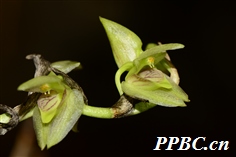綠花大苞蘭檢視原始碼討論檢視歷史
| 綠花大苞蘭 |
 |
|
中文名:綠花大苞蘭 界:植物界 亞 界:綠色植物亞界 總 門:輪藻總門 門:木賊門(有胚植物門) 亞 門:木賊亞門(維管植物亞門) 綱:木蘭綱(被子植物綱) 亞 綱:百合亞綱 超 目:天門冬超目 目:天門冬目 科:蘭科 屬:大苞蘭屬 種:綠花大苞蘭 |
綠花大苞蘭(lǜ huā dà bāo lán),學名:Sunipia annamensis (Ridley) P. F. Hunt,異名:Ione annamensis :Rhizome creeping, ca. 2 mm in diam. Pseudobulbs ca. 1.5 cm apart on rhizome, ovoid, 1.7-2.5 cm, ca. 13 mm in diam., with 1 leaf at apex. Petiole ca. 15 mm; leaf blade erect, oblong, 8.5-11 × 2-2.5 cm, thickly leathery, base contracted into petiole, apex obtuse and retuse.,產於海拔2400米,分布於雲南省。 [1]
形態特徵
Rhizome creeping, ca. 2 mm in diam. Pseudobulbs ca. 1.5 cm apart on rhizome, ovoid, 1.7-2.5 cm, ca. 13 mm in diam., with 1 leaf at apex. Petiole ca. 15 mm;
leaf blade erect, oblong, 8.5-11 × 2-2.5 cm, thickly leathery, base contracted into petiole, apex obtuse and retuse. Scape erect, 15-35 cm; raceme erect, 4-6-flowered;
peduncle 12-30 cm, 1.5-2 mm in diam., with 6 sheaths 1.5-2 cm; floral bracts ovate to triangular, 10-12 mm, membranous, apex acuminate. Pedicel and ovary 10-13 mm.
Dorsal sepal ovate, ca. 10 × 6-7 mm, 7-veined, apex rounded to obtuse; lateral sepals ovate, 11-14 × ca. 5 mm, lower edges free or ± connate (see note below) to each other in basal half, apex acute.
Petals ovate-triangular, 5.5-6 × 5.5-6 mm, 3-veined, margins erose-denticulate, apex obtuse; lip ± cordate to rhombiform, 7-9 × 7-10 mm, slightly narrowed and thickened in apical half, apex obtuse. Column ca. 2 mm, stout, base with a foot ca. 1 mm; each pair of pollinia with a stipe and a viscidium. Fl. Oct.
分類文獻
FOC >> Vol.25 (2009) >> Orchidaceae >> Sunipia 7.Sunipia annamensis (Ridley) P. F. Hunt Kew Bull. 26: 183. 1971.
綠花大苞蘭 lü hua da bao lan Ione annamensis Ridley, J. Nat. Hist. Soc. Siam 4: 115. 1921.
產地生境
Tree trunks in forests; ca. 2400 m. S Yunnan (Lüchun) [Thailand, Vietnam].
辨析
X. H. Jin et al. (Acta Bot. Yunnan. 29: 394. 2007) reported Sunipia annamensis from the locality given above. Their description may well refer to this species, although they described the lateral sepals as connate. We have not seen the specimen (X. H. Jin 8545, PE).
The Chinese record needs confirmation.X. H. Jin et al. (Acta Bot. Yunnan. 29: 394. 2007) reported Sunipia annamensis from the locality given above. Their description may well refer to this species, although they described the lateral sepals as connate. We have not seen the specimen (X. H. Jin 8545, PE). The Chinese record needs confirmation.
植物文化
蘭花是中國最古老的花卉之一,早在帝堯之世就有種植蘭花的傳說。古人認為蘭花「香」、「花」、「葉」三美俱全,又有「氣清」、「色清」、「神清」、「韻清」四清,是「理想之美,萬化之神奇」。最早賦予蘭花一定人文精神的是孔子,據東漢蔡邕《琴操》載:孔子自衛反魯,隱谷之中,見幽蘭獨茂,蔚然嘆曰:「蘭當為王者香」。
真正的蘭花文化則起源於戰國時期楚國的愛國詩人屈原,他種蘭、愛蘭、詠蘭,以蘭花為寄託,千百年來一直影響着後人。
後世詩人在詠蘭時,也有許多的名句,比如陳子昂的「歲華盡搖落,芳意竟何成」。劉克莊的「一從夫子臨軒顧,羞伍凡葩鬥豔濤」。詩人們將蘭花的高潔與人格的完美聯繫起來,使得蘭花文化不斷得以拓展和延續。
蘭花以高潔、清雅、幽香而著稱,葉姿優美,花香幽遠。自古以來,蘭花都被譽為美好事物的象徵,已廣泛在民間人格化了。蘭花對社會生活與文化藝術發生了巨大的影響。父母以蘭命名以表心,畫家取蘭作畫以寓意,詩人詠蘭賦詩以言志。蘭花的形象和氣質久已深入人心,並起着潛移默化的作用。
古代舞劇以「蘭步」、「蘭指」為優美動作,把優秀的文學作品和書法作品稱為「蘭章」,把真摯的友誼叫做「蘭交」,把人的芳潔、美慧喻為「蘭心蕙質」。又把傑出人物的去世比作「蘭摧玉拆」。蘭花在中國人民心目中,已經成為一切美好事物的寄寓和象徵。